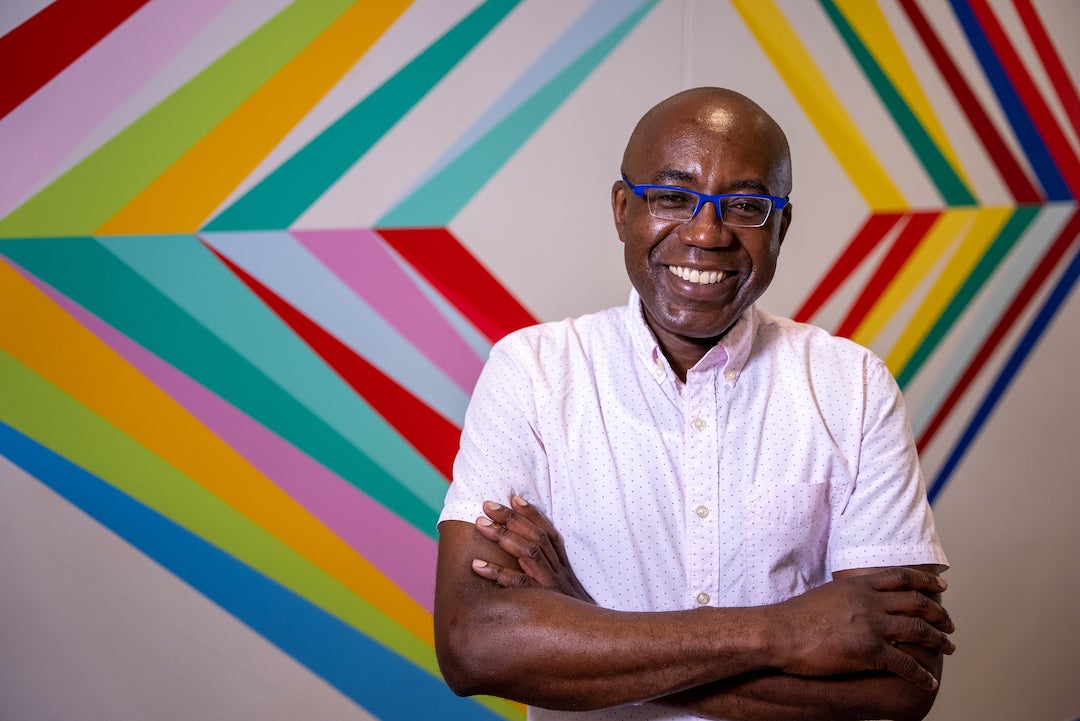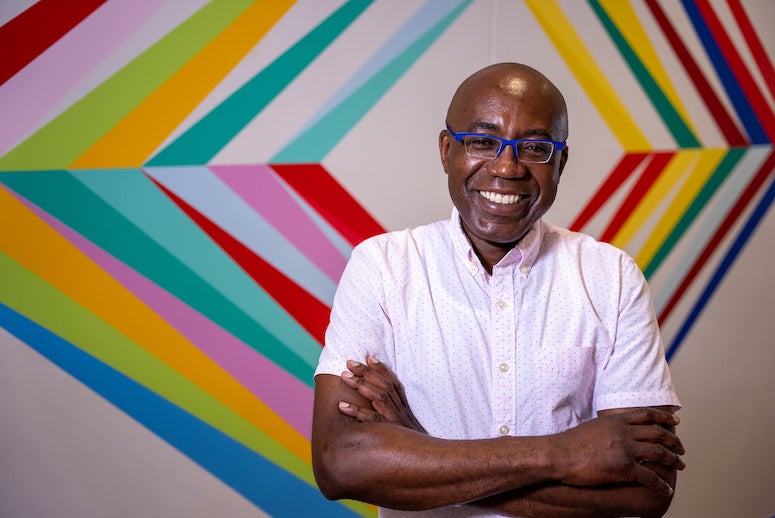
Inside the Shepherd School of Music’s Alice Pratt Brown Hall, countless guests have been wowed over the years by the talented students who spend untold hours in the building perfecting and performing their art. But the stark white walls that line many of its interior walkways stood in contrast to the vibrant performances and dynamic learning environment inside.
Now, thanks to the work of esteemed Nigerian American abstract artist Odili Donald Odita, those once-bare walls are now bursting with color and light.
Commissioned by the Moody Center for the Arts for Rice’s public art collection, Odita’s “Meeting Space / Painting with Changing Parts” isn’t just the first original work by a Black artist commissioned at Rice. It also represents a wholesale reimagining of the space in which it resides, a visual companion to the sonorous tones that helped inspire its creation.
“The ways in which color can reflect sound and the relationship between our visual and auditory senses are exciting concepts to think about,” said Alison Weaver, the Suzanne Deal Booth Executive Director of the Moody. “Odili’s work reflects those intersections, and that’s why we think he is the perfect artist to create a site-specific work for this space.”
Odita’s wall painting weaves its way through Alice Pratt Brown Hall, its kaleidoscopic array of vibrant colors drawing from traditional African motifs and the subtly shifting hues he observed on campus during his visit in the spring of 2020. The bright pops of color in oft-repeating shapes and forms throughout the mural also represent a visual interpretation of the way musical compositions rely on solid, structured backbones while they simultaneously change and evolve with each unique performance.
“Color and light are shifting, and that’s representative to me of the pulsation of music, the force of music through air and sound,” Odita said of his mural. “It’s the idea of the way one could imagine music being written, or if you saw music as a color blip, how it might shift, change and rotate in space over time.”
The work was also informed by James Turrell’s “Twilight Epiphany” Skyspace, which directly faces the lounge and corridor now home to Odita’s mural. Odita intended his angular, elevated abstractions to evoke “Twilight Epiphany,” which has patrons gazing upward at its dynamic sunrise and sunset light sequences each day.
The first part of the work’s title references Quaker meeting houses, communal spaces where adherents gather to sit in contemplative thought, as a nod to Turrell’s faith and the experiences Odita’s daughter had attending Quaker schools. The second part is Odita’s ode to experimental American composer Philip Glass, whose groundbreaking compositions, including “Music with Changing Parts,” influenced a generation of avant-garde artists from a variety of disciplines.
“It became very appropriate for me to consider all of this together in the way that I’m dealing with these spaces — that this work, like all art, is a space for contemplation and a space to gather,” Odita said.
Students in the Shepherd School have been effusive about how Odita’s mural, now a permanent fixture, has transformed and enlivened the space, providing inspiration for the bright minds that walk past its bold patterns each day.
“It brightens up the place a lot,” said Rice music major Lydia Hanje. “I feel like it represents the people more — bright and lively. It’s great.”
Fellow Shepherd School student and composition major Joanna McDonald agreed. “I’m a composer, and colors mean a lot to me, especially with music. I always appreciate it when I can see color in a space. It makes it alive, awake and happy,” McDonald said.

